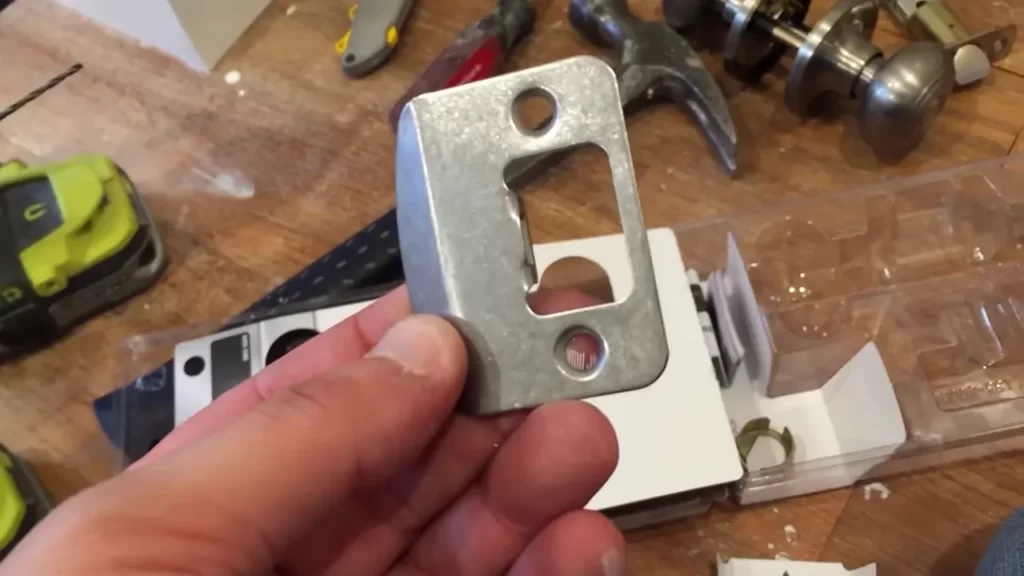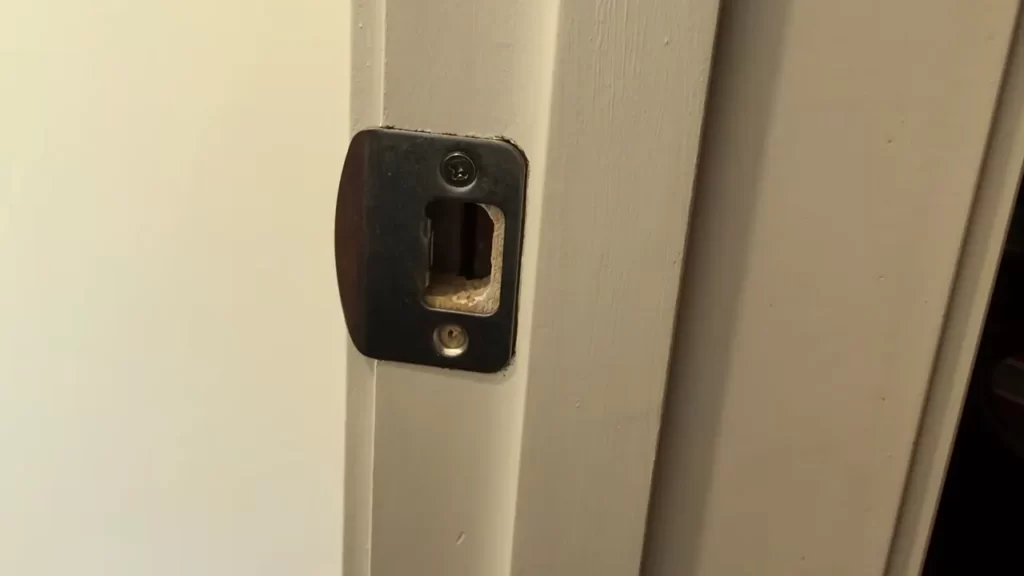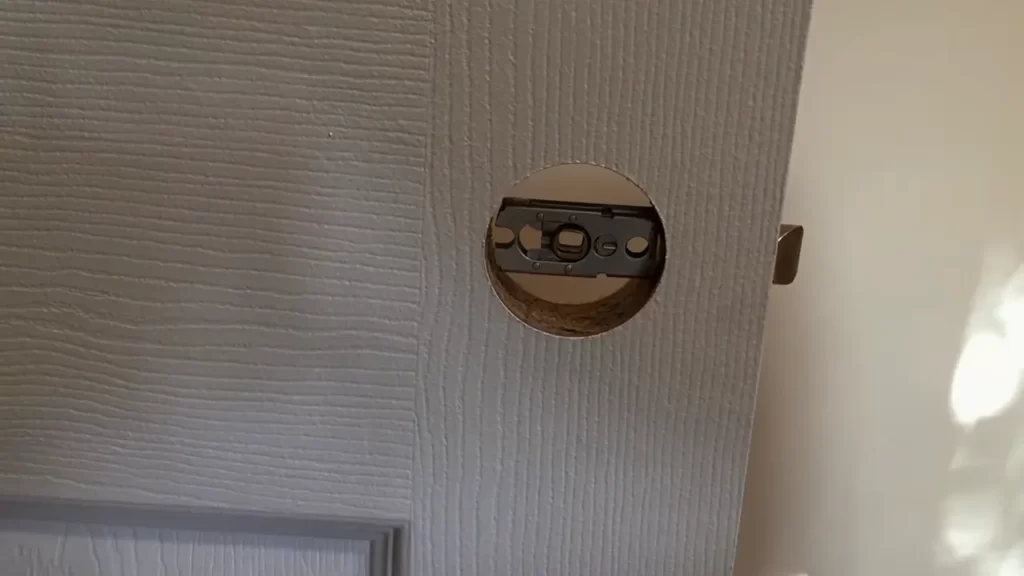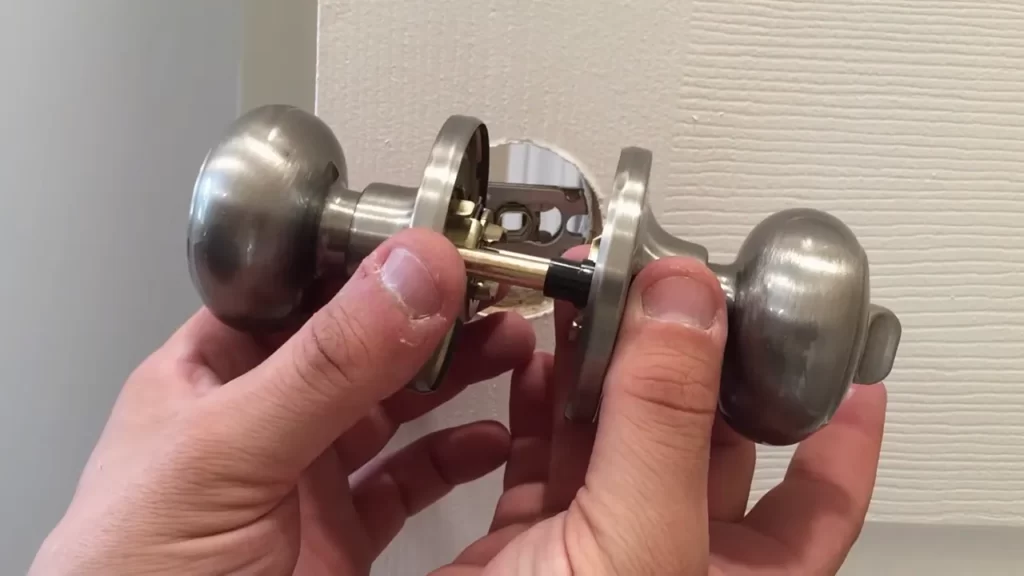To install an interior door knob, first, position the latch plate against the hole and mark the outline on the door. Then, chisel the outline to create a recess for the latch plate.
Finally, attach the knob by inserting the spindle into the latch assembly, and tighten the screws. Are you looking to add a finishing touch to your interior doors? Installing a door knob not only enhances the aesthetics but also provides privacy and security.
Whether you’re replacing an old knob or installing a new one, this step-by-step guide will walk you through the process. Learn how to position the latch plate, chisel the recess, and attach the knob to create a seamless and functional door knob installation. With a few tools and some patience, you can easily accomplish this home improvement task. Let’s get started!
Choosing The Right Door Knob

Selecting the perfect door knob for your interior doors is an important decision that can greatly impact the overall look and functionality of your space. Whether you’re replacing an old knob or installing a new one, it’s crucial to choose a door knob that not only complements your interior design but also ensures a proper fit with the door itself.
Factors to consider when selecting an interior door knob
When choosing an interior door knob, there are several factors to consider. These factors will help guide you in making the right choice that suits your needs and preferences:
- Style and Design: The first thing to consider is the style and design of the door knob. It should match the overall interior design of your space. For example, if you have a modern or contemporary interior, sleek and minimalistic door knobs would be a perfect choice. On the other hand, if you have a more traditional or vintage interior, ornate or antique-style door knobs can add a touch of elegance to your doors.
- Functionality: Another important factor to consider is the functionality of the door knob. Do you need a privacy lock for a bedroom or bathroom door? Or do you prefer a passage knob for a closet or hallway door? Additionally, consider if you want a door knob with a locking mechanism or a simple non-locking one.
- Durability: The durability of the door knob is essential, especially for frequently used doors. Opt for high-quality materials such as solid brass or stainless steel that ensure long-lasting performance.
- Ergonomics: Comfort is crucial, especially for door knobs used on doors you frequently open and close. Consider the shape and grip of the door knob to ensure easy and comfortable handling.
- Budget: Finally, consider your budget. Door knobs are available at various price points, so make sure to set a budget and choose a knob that fits within your financial constraints.
Matching the knob style with the overall interior design
One of the most important aspects of choosing the right door knob is matching its style with the overall interior design of your space. This will create a cohesive and visually pleasing look throughout your home. Here are a few tips to help you accomplish that:
- Consider the existing hardware and finishes in your space. If you have chrome or brushed nickel fixtures, opt for door knobs with matching finishes.
- Take into account the architectural style of your home. For example, if you have a farmhouse-style interior, rustic or antique-style door knobs can enhance the charm of your space.
- Don’t be afraid to mix and match styles. Unique and eclectic combinations can add character and personality to your interior design, as long as they are done tastefully and thoughtfully.
Ensuring the knob’s compatibility with the door
Before purchasing a door knob, it’s important to ensure its compatibility with the door itself. Here are a few considerations:
- Measure the door’s thickness. Most standard door knobs are designed to fit doors that are 1 3/8″ to 1 3/4″ thick. If your door is thicker or thinner, you may need to purchase a special door knob that accommodates the door’s thickness.
- Determine the door’s backset. The backset is the distance from the edge of the door to the center of the borehole. It’s typically either 2 3/8″ or 2 3/4″. Make sure to choose a door knob with a matching backset measurement.
- Consider the door’s material. Different door materials may require different types of door knobs and installation methods. For example, a solid wood door may require a different type of installation than a hollow core door.
By considering these factors and ensuring compatibility, you’ll be able to choose the perfect door knob that not only enhances the aesthetic appeal of your space but also functions seamlessly with your interior doors.
Measuring And Preparing The Door

Installing a new interior door knob can instantly update the look of your home and add a touch of elegance. Whether you’re replacing an old, worn-out knob or just looking to make a change, the process can be straightforward if you follow the right steps. In this section, we’ll guide you through the important steps of measuring and preparing the door for your new knob installation.
Taking accurate measurements for the new knob installation
Before you start removing the existing knob and hardware, it’s crucial to take precise measurements to ensure a proper fit for your new door knob. Here’s what you’ll need to do:
- Measure the “backset” – the distance from the edge of the door to the center of the existing bore hole. Typically, interior doors have a backset of either 2-3/8 inches or 2-3/4 inches. Check the backset of the new knob you purchased and adjust accordingly.
- Measure the diameter of the bore hole – this will help you determine the size of the new door knob that will fit properly. Most interior doors will have a standard bore hole diameter of 2-1/8 inches.
- Check the door thickness – measure the thickness of your door to make sure the new knob’s latch assembly will fit. Standard interior doors are typically 1-3/8 inches to 1-3/4 inches thick.
Once you have all the measurements, you’ll be ready to move on to the next step.
Removing the existing knob and hardware
Now that you have the necessary measurements, it’s time to remove the existing knob and hardware. Follow these steps:
- Locate the screws on the interior side of the door holding the knob together.
- Using a screwdriver, unscrew the screws and separate the two knobs.
- Once the knobs are off, remove the latch plate and strike plate from the door jamb using a screwdriver.
- Inspect the door for any remaining hardware or screws and remove them as well.
After removing all the old hardware, you’ll be ready to prepare the door for the new knob.
Preparing the door surface for the new knob
Before installing the new door knob, it’s important to ensure that the door surface is clean, smooth, and ready for the installation. Follow these steps:
- Fill any existing holes or damage on the door surface using a wood filler that matches the color of your door. Allow it to dry and then sand it smooth.
- Use a chisel to create a shallow recess in the edge of the door where the latch plate will sit. This will help ensure a snug fit.
- If necessary, use a hole saw or spade bit to enlarge the bore hole to accommodate the new door knob. Take your time and be careful not to splinter the door surface.
- Lastly, give the door surface a thorough cleaning to remove any dust or debris before proceeding with the installation.
With the door measurements taken, the old knob and hardware removed, and the door surface prepared, you’re now ready to proceed with the next steps of installing your new interior door knob.
Installing The Interior Door Knob
Are you looking to give your interior doors a fresh update? Installing a new door knob can be a simple and effective way to enhance the appearance of your doors. In this guide, we will walk you through the step-by-step process of installing an interior door knob. Let’s get started with assembling the knob components.
Assembling the knob components

Before you begin the installation process, it’s important to ensure that you have all the necessary components for your door knob. Typically, a door knob set will include the knob itself, a latch, a strike plate, and all the screws and hardware needed for installation.
Start by unpacking the components and familiarizing yourself with each one. Check that the latch fits snugly into the latch hole, and that the strike plate aligns with the latch properly.
Positioning and marking the knob’s placement
Once you have assembled the knob components, the next step is to determine the position of the knob on the door. Take the door knob and hold it against the door, at the height where you want it to be installed.
Mark the center of the hole for the doorknob on both sides of the door using a pencil or marker. This will serve as a guide for drilling the necessary holes.
Drilling the necessary holes for the knob and latch
Now it’s time to drill the holes for the knob and latch. Start by using a drill bit that is slightly smaller than the diameter of the latch hole. Carefully drill a hole through the door at the marked location for the latch.
Next, switch to a larger drill bit and create a larger hole on the side of the door, where the doorknob will be installed. Make sure to drill all the way through the door, creating a clean and even hole.
Attaching the latch and strike plate
With the holes drilled, you can now attach the latch and strike plate. Insert the latch into the hole you drilled earlier, making sure it fits securely. Then, use the provided screws to secure the latch in place.
Next, take the strike plate and align it with the latch. Mark the screw holes with a pencil, and then remove the strike plate. Pre-drill holes for the screws, and then attach the strike plate to the door using the screws provided.
Connecting the knob and tightening the screws
Finally, it’s time to connect the knob components and tighten the screws. Take the door knob and insert the spindle into the hole on the side of the door. Make sure it fits snugly.
Hold the knob in place and insert the screws through the holes on the base of the knob, into the threaded holes on the spindle. Use a screwdriver to tighten the screws until the knob is securely attached to the door.
Once everything is tightened, test the door knob and ensure it turns smoothly without any resistance. If necessary, make any adjustments to ensure proper functionality.
Now you’re all set! By following these steps, you can easily install an interior door knob and give your doors a stylish upgrade. Enjoy your newly enhanced doors!
Troubleshooting Common Issues

While installing an interior door knob may seem like a straightforward task, it’s common to encounter some issues along the way. This section will guide you through troubleshooting the most common problems that may arise during the installation process. By addressing these issues, you can ensure that your door knob functions smoothly and securely. Let’s take a look at how to adjust the latch for a proper fit, fix loose or squeaky knobs, and solve alignment issues with the strike plate.
Adjusting the Latch for a Proper Fit
One common issue you may encounter when installing an interior door knob is the latch not fitting properly into the strike plate. This can result in the door not closing correctly or having difficulty latching. To resolve this problem, follow these steps:
- Close the door and check the alignment of the latch with the strike plate. If the latch isn’t aligned properly, it may hit the strike plate at an angle.
- Remove the strike plate by unscrewing the screws that hold it in place. Take note of the position of the strike plate to ensure it is reinstalled correctly.
- Use a chisel or file to adjust the strike plate by removing small amounts of material from the area where the latch hits. This will create a better alignment.
- Reinstall the strike plate and check the latch’s alignment once again. It should fit snugly into the strike plate without any resistance.
Fixing Loose or Squeaky Knobs
Another common problem with interior door knobs is when they become loose or start to squeak. Loose knobs can be frustrating, while squeaky knobs can be annoying. But don’t worry, as these issues can often be easily resolved. Here’s what you can do:
- Check the knob’s mounting screws. If they are loose, tighten them using a screwdriver.
- If the knob continues to be loose, try using a longer screw to ensure a more secure fit. Make sure the longer screw doesn’t interfere with the door’s movement.
- To fix a squeaky knob, apply a lubricant such as WD-40 to the moving parts of the knob. Be sure to wipe off any excess lubricant afterwards.
Solving Alignment Issues with the Strike Plate
When the strike plate is not aligned properly, the latch may not fully engage, resulting in difficulty closing the door or even the latch not catching at all. Here’s how you can solve alignment issues with the strike plate:
- Close the door and observe where the latch hits the strike plate. If it is misaligned, you may notice gaps between the latch and the strike plate.
- Remove the strike plate by unscrewing the screws. Use a chisel or file to enlarge the strike plate’s opening in the direction needed for alignment.
- Reinstall the strike plate and check the latch’s alignment with the newly adjusted strike plate. The latch should easily slide into the strike plate without any resistance.
By troubleshooting these common issues during the installation of your interior door knob, you can ensure a secure and functional door knob that will stand the test of time.
Maintaining And Caring For Door Knobs
Proper maintenance and care for your interior door knobs will ensure their longevity and functionality. Regular cleaning, lubrication, and inspection of screws are essential to keep them in optimal condition. In this section, we will discuss the important steps to take when maintaining and caring for your door knobs.
Cleaning and Polishing the Door Knobs Regularly
To keep your door knobs looking their best, it’s important to clean and polish them regularly. Follow these simple steps to maintain their shine:
- Start by removing any visible dirt or grime from the door knob using a soft cloth or sponge dampened with mild soap and water.
- Gently scrub the surface of the door knob, paying attention to any crevices or intricate designs.
- Rinse the door knob with clean water to remove any soap residue.
- Dry the door knob thoroughly with a clean, lint-free cloth.
- Once the door knob is dry, apply a small amount of brass or metal polish to a soft cloth.
- Gently rub the polish onto the surface of the door knob, following the manufacturer’s instructions.
- Buff the door knob with a clean cloth until it shines.
Regularly cleaning and polishing your door knobs will not only enhance their appearance but also remove any accumulated dirt or grime that may affect their functionality.
Lubricating Moving Parts for Smooth Operation

In order for your door knobs to operate smoothly, it’s important to lubricate the moving parts on a regular basis. Follow these steps to ensure smooth operation:
- Start by using a screwdriver to remove the screws securing the door knob to the door.
- Once the door knob is removed, use a silicone-based lubricant or a lightweight household oil to lubricate the moving parts inside the door knob mechanism.
- Apply a small amount of lubricant to a cloth or rag and wipe it onto the moving parts.
- Make sure to lubricate the latch mechanism as well.
- Reattach the door knob to the door by securing it with the screws.
Lubricating the moving parts of your door knobs regularly will ensure smooth and effortless operation, preventing any unnecessary strain or damage.
Inspecting and Tightening Screws Periodically
Periodically inspecting and tightening the screws on your door knobs is crucial to maintain their stability and prevent them from becoming loose. Here’s what you need to do:
- Using a screwdriver, check each screw on the door knob for any signs of looseness.
- If a screw is loose, tighten it by turning it clockwise until it is snug but be careful not to overtighten as it may damage the knob or the door.
- If any screws are missing or damaged, replace them with new ones of the same size and material.
- After tightening or replacing any screws, test the door knob to ensure it operates smoothly.
By inspecting and tightening the screws periodically, you can prevent wobbly door knobs and ensure their longevity.
In conclusion, taking the time to clean, lubricate, and inspect your interior door knobs will go a long way in maintaining their appearance and functionality. By following the steps outlined above, you can keep your door knobs in excellent condition for years to come.
Frequently Asked Questions Of How To Install Interior Door Knob
How Do You Install An Interior Door Handle?
To install an interior door handle, start by removing the old handle and latch plate. Then, align the new handle and attach it using screws provided. Lastly, attach the latch plate and test the handle for smooth operation.
Is Installing A Door Knob Hard?
Installing a door knob is not hard. Just follow the instructions carefully, with the necessary tools. Position the knob, insert the spindle and latch, screw on the faceplate, and tighten the screws. Test the knob to ensure it works smoothly.
Where Is The Correct Placement Of Door Knobs?
Door knobs should be placed at a height of 36 to 42 inches from the floor. They are typically positioned on the side of the door opposite the hinges.
Can You Install A Door Knob Yourself?
Yes, installing a door knob yourself is possible. Just follow the provided instructions carefully.
Conclusion
To sum up, installing an interior door knob is a simple process that can greatly enhance the appearance and functionality of your doors. By following the step-by-step instructions outlined in this guide, you can easily complete the installation yourself. Remember to gather all the necessary tools and materials beforehand, and take your time to ensure proper alignment and functioning.
With a little patience and attention to detail, you can effortlessly transform your doors and give them a fresh new look.
